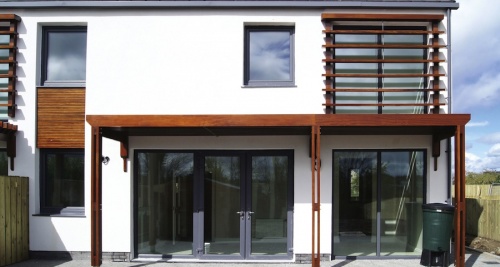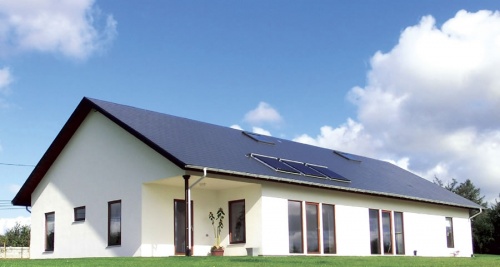A passive house time-lapse from Cork
We tip our proverbial hats to Cork-based timber frame manufacturer Eco Timber Frame who have posted time-lapse video of one of their recent passive house projects online.
Wexford passive house wins Isover energy efficiency award
Isover Ireland held their annual Energy Efficiency Awards in Dublin on Friday 1 March in Dublin. The awards recognise low energy renovation and new build projects in both the residential and commercial sectors. Isover award ceremonies are held in individual countries, with national winners going forward to Isover's European Energy Efficiency Awards. At the Dublin ceremony, Isover announced that the 2014 European awards will take place in Ireland.
A passive house inspired by the sun
The Equinox House house near Kavarna, Bulgaria is a passive building that "delicately interacts with natural phenomena on all levels from embracing local views to tracing universal solar motions," according to its designers, Ignatov Architects.
A tribute to eco-architect Howard Liddell
In this moving tribute, Paul Leech of Gaia Ecotecture pays tribute to leading ecological architect Howard Liddell, who passed away last week.
An 'active house' built from shipping containers
The worldFLEXhome is a factory-manufactured house constructed from old shipping containers that uses less energy than it produces.
LEED silver home graces Utah canyon
Located in Emigration Canyon above Salt Lake City, Utah, this contemporary family home of 232 square metres was built for a couple with young children, and was designed to maximise views of the canyon.
Socioeconomic factors hindering UK passive house growth, report claims
The passive house standard may be growing in popularity, but the UK could struggle to follow Germany’s lead and build large numbers of passive homes because of its different social, political and financial drivers and general attitudes, according to a report published by the NHBC Foundation.
Timber house in Scottish Borders built without nails or glue
The new issue of Passive House Plus includes our first ever Brettstapel building, a type of massive timber construction that uses no glues or nails, and that makes use of low grade timber otherwise unsuitable for construction.
What makes wood products so sustainable?
Truly efficient building design starts with sustainable materials, writes SmartPly's George Watson. Truly sustainable materials not only stand the test of time and make a positive contribution to the performance of buildings, he says, but have a low level of embodied energy and can be specified with confidence in their legal, sustainable and health and safety credentials.
Comment - Why the path to recovery will be passive
MosArt & Passive House Academy co-founder Tomás O’Leary sees great prospects for Ireland’s beleaguered construction sector – if we embrace the passive house approach
Circulation & readership: our approach explained
Circulation and readership aren’t the same thing, though some people conflate them.
Circulation’s easy to measure – if you’re willing to subject your magazine to the scrutiny of independent auditing – but readership’s another matter. So let’s deal with circulation first.
China plans world's tallest building, but do green claims stack up?
Perhaps not surprisingly, Dubai's 828 metre Burj Khalifa might soon be overtaken as the world's tallest building. What's more, construction firm Broad Sustainable Building plans to build the 838 metre Sky City tower in Changsha, China in just 90 days.
Treehouses for grown-ups
Who wouldn't love a treehouse to escape to, whatever your age? Seen as a way to combine modern living with design that fits neatly in its landscape, architect-designed treehouses seem to be all the rage right now - whether as secluded escapes or permanent residences.
Why Construct Ireland is becoming Passive House Plus
We’ve just published the final issue of Construct Ireland. I say those words not with despondency but with excitement. Mercifully, we haven’t fallen victim to the decline of the construction industry, like so many other construction magazines. Nor are we suffering the fate anticipated for so many magazine titles, with collapses in sales, subscriptions and advertising revenue from print versions not being countered by sufficient income from websites or apps.
Meeting Part L compliance with solar electricity in apartments and large houses
Using solar thermal systems to meet the Part L renewable energy requirement in apartment blocks can be problematic. Long pipe runs in apartment blocks drastically reduce the efficiency and increase the cost of installation. Unoccupied dwellings have overheating problems, and the entire system requires regular maintenance. Photovoltaic systems suffer none of these disadvantages, and are simple and quick to install.
76% of new builds go passive or near passive
Over three out of four domestic new build enquiries to Construct Ireland are from people aiming for certified passive or near passive standards, the latest data from our reader enquiry service reveals.
The enquiry system connects readers looking to build or upgrade with the sustainable product and service providers who advertise in the latest issue of Construct Ireland.
Tiny homes: a documentary
Hey everyone, check out this trailer for Tiny, a documentary about "one man’s attempt to build a tiny house from scratch in the mountains of Colorado". According to its website, the film is a "a meditation on the relationship of home to environment". It's set to be released later this summer. I blogged about the small house movement before here.
The printable house
SEAI opens up with Building Energy Rating database
In an act of laudable transparency, the Sustainable Energy Authority of Ireland has put every the details of every Building Energy Rating yet published for dwelling in the country online. The SEAI National BER Research Tool includes information from almost 290,000 BERs for new and existing homes that have been published to date, along with provisional BERs.


















